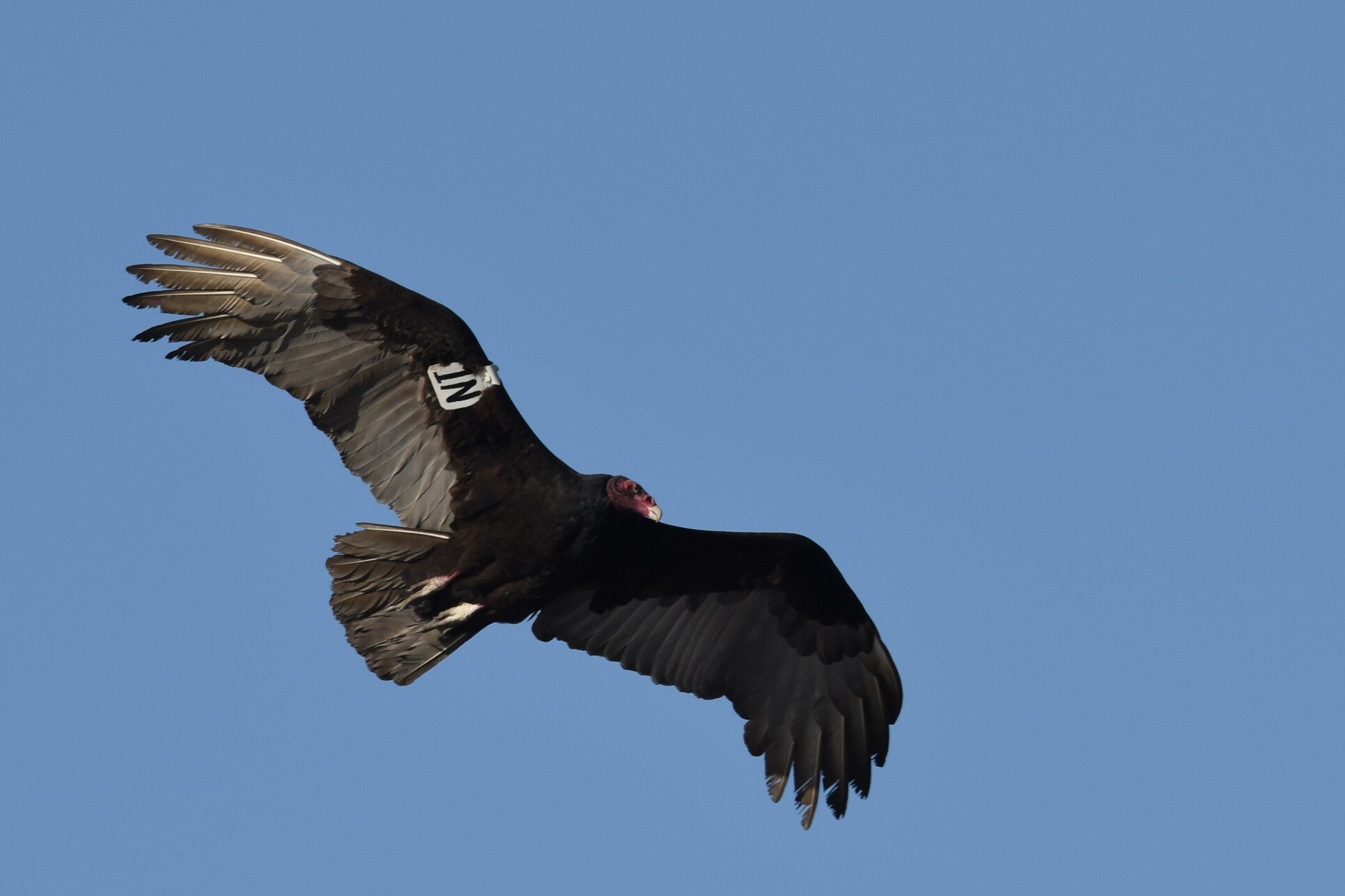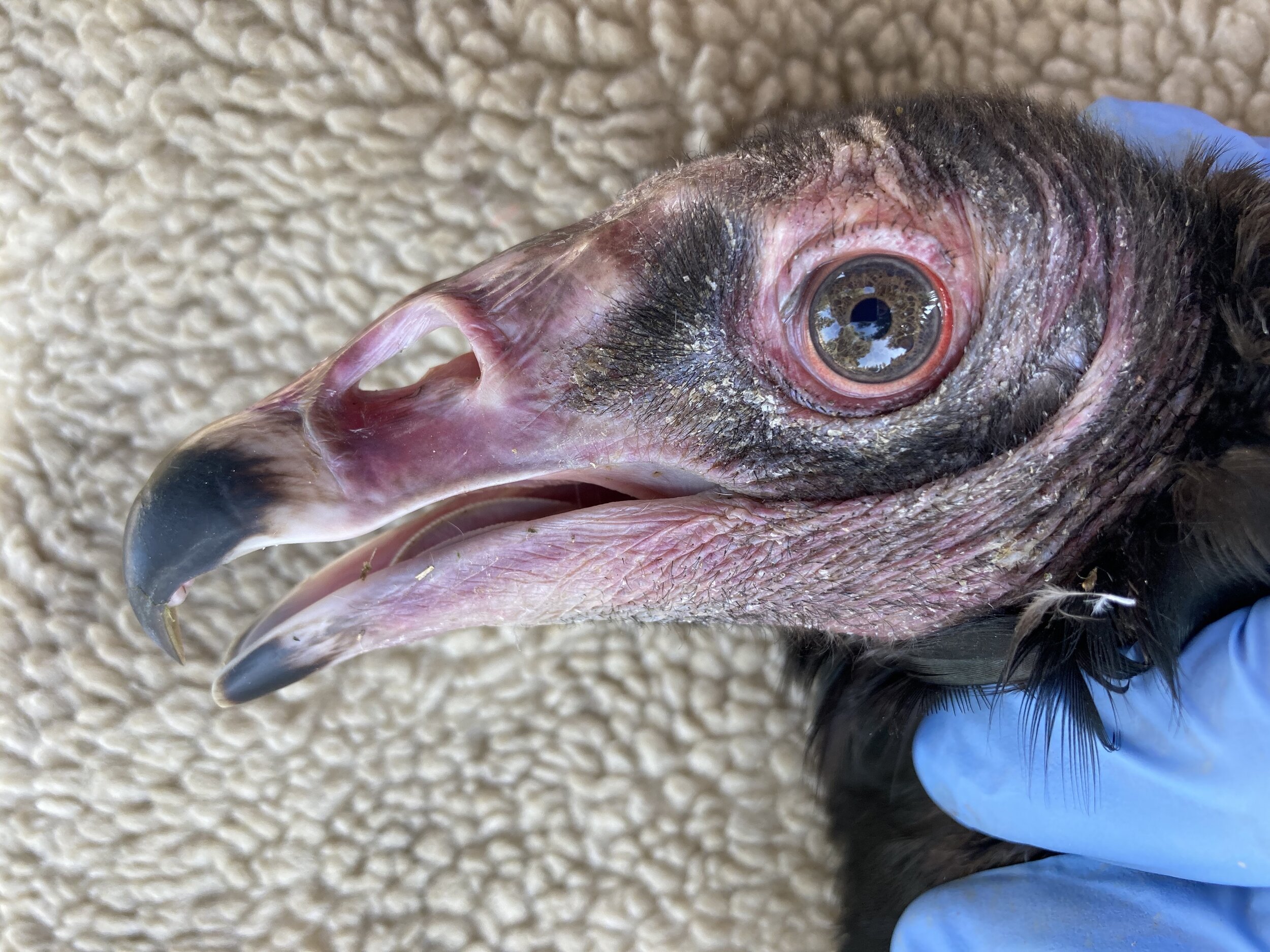“I saw a large black bird with a white tag on its wing!”
This is one of the most common emails we get from the public here at BBI (and our non-profit, BRI), so we decided to write an article to help explain who these birds are and why they have been marked for research.
“1N”. Photo Copyright: Nicollet Overby (2021).
In southern California, those large black birds with white tags are most likely Turkey Vultures.
And if you have sent us one of those emails, THANK YOU!! You have contributed an important data point to our 20+ year ongoing research project, which includes monitoring lead toxicity as well as migratory and dispersal patterns in Turkey Vultures. Without these publicly reported sightings, our data set would be very small and so much less informative.
So what is a Turkey Vulture? Turkey Vultures are in the family Cathartidae, also known as the “New World Vultures”. That family also includes California Condors, but Turkey Vultures are much smaller in size compared to condors, with a wingspan of about 5.5 feet (condor wings stretch over 9 feet across).
A Turkey Vulture stretching their wings full length in the early morning sun – this increases the surface area of their bodies, and helps them to warm up quickly after a cool night. Photo Copyright: Nicollet Overby (2021).
Photo taken during a 2020 trapping and tagging project.
Genetically, New World Vultures were thought to be more closely related to storks than to birds of prey, but in most ways are more similar to raptors than storks. They are a ubiquitous bird, with the Cornell Lab of Ornithology estimating that approximately 18 million Turkey Vultures can be found around the world today. They have an amazing sense of smell, which helps them detect dilute volatile gasses coming from the bodies of dead animals, even while soaring hundreds of feet in the air. In 2017, a study proved that Turkey Vultures have a significantly larger olfactory bulb (the brain structure that receives information detected within the nasal cavity) relative to brain volume, and more mitral cells (neurons that process and send olfactory information to other parts of the brain) than any other avian species previously measured. Turkey Vultures have the largest nares (nostrils) of the New World Vultures, and like condors there is no septum dividing the nasal passages – so you can see right through from one side to the other! This allows more scent molecules to enter the nasal cavity and is also much easier to keep clean.
The Turkey Vulture’s scientific name (Cathartes aura) means “Cleansing Breeze” in Latin. A very fitting name for the species that is also colloquially referred to as “Nature’s Clean-Up Crew”. The common name Turkey Vulture was assigned because their bald head vaguely resembles that of a wild turkey. But unlike turkeys, or most other birds for that matter, vultures are obligate scavengers. This means that they only feed on dead animals, and their bodies are perfectly designed for that task. Their incredible sense of smell helps them detect freshly deceased animals, and those featherless heads stay relatively clean even when they are rooting around deep body cavities. Turkey Vultures do not kill their own food, so their sharp beaks are only used for tearing open tough hides and shredding large sections of flesh on animals that are already dead. Even though their wings measure almost 6 feet across, their total body weight is only between 2-4 pounds. Like most other birds, their bones are hollow, with thin structures called struts that bisect the interior in several locations, which make the bones very strong despite being hollow. Their light body, combined with their large wings, enables them to soar very high and for long distances. Pilots have reported seeing Turkey Vultures soaring at 20,000 feet. They often catch atmospheric updrafts, known as “thermals”; as the ground is warmed by the sun, the air above the ground begins to heat as well, creating a convective current that transfers heat vertically through the atmosphere. They are so good at utilizing these updrafts that other raptors have learned to look for gracefully soaring Turkey Vultures to find and take a ride on a thermal themselves. Think of a thermal as a bird’s “cruise control” – since the heat in the air is doing all the work to lift them in the atmosphere, they don’t have to expend energy by flapping their wings, they can just soar. The bigger the wings, the better the lift and the farther they can soar. Scientific studies have shown that Turkey Vultures can travel up to 200 miles per day riding these thermals.
On land, Turkey Vultures appear a little clumsy, often seen doing a loping hop-skip on feet that look a bit like a chicken’s. Unlike other raptors, who have large, strong, curved talons to help with catching and killing prey, Turkey Vultures have long toes with flatter, more blunt talons which are better for standing on the ground. They have featherless legs, and engage in a body function called “urohidrosis”, which most simply means they urinate on their legs as a cooling method. The eliminated waste contains properties that also helps get rid of any bacteria that may be on their skin from walking through rotting carrion on a regular basis. Urohidrosis will later play a very important role in how Turkey Vultures are marked for research. If a Turkey Vulture feels threatened, they may empty their stomachs by vomiting semi-digested food in the direction of the threat, which serves two purposes. First, it lightens their load, which means they can take flight quicker and escape faster if needed. And second, the foul-smelling vomit, comprised of decaying flesh and strong, burning stomach acids, can quickly send a would-be predator on a hasty retreat. The immune system of Turkey Vultures is wonderfully robust. They can feast on carcasses contaminated with pathogenic bacteria (i.e. anthrax, botulism, cholera and salmonella), usually without being affected. They provide a natural environmental clean-up service like no other, making them one of the most important species here on earth.
Without vultures, ecosystems can quickly become out of balance. They are a key component in the circle of life, and help prevent harmful bacteria from accumulating in the environment. And while they do have incredible immune systems, they can still be vulnerable to certain toxins, such as those found in rodenticides or pesticides, due the chemical agents in these poisons. In Europe, the intentional use of poisoned bait (usually livestock carcasses filled with deadly poisons like carbamate pesticides) as a poor attempt at reducing predators has become a common problem. Poisoned bait is incapable of targeting a specific problem predator, harms scavengers and predators alike, and has been banned by the Birds and Habitats Directive and the Bern Convention of European Wildlife and Natural Habitats in Europe, but unfortunately the practice still occurs and vultures are suffering greatly.
Poisoning is not always intentional, but unregulated use or abuse of pharmacological drugs in livestock can also be problematic. For example, in India, vultures began dying from consuming dead cattle who had been treated with an arthritis drug (Diclofenac). Without vultures, feral dogs began filling the role of “clean-up crew”, and the dogs were not negatively affected by the drug. Unlike vultures, feral dogs will also attack and/or kill other animals, and can be infected with rabies if not vaccinated. Since most feral dogs in India are not vaccinated, incidences of rabid dogs attacking people has risen in correlation with the vultures’ deaths. Rabies is a fatal disease, and often cannot be treated other than palliatively once clinical signs appear. While many warm-blooded animals are susceptible to rabies, it is not typically considered to be an avian disease and is not known affect wild birds naturally. This is due in part to differences in mammalian and avian proteins that the rabies virus would bind to, therefore even scavenger birds that consume rabies-infected mammals are not considered a risk for transmission to humans or other animals.
Lead is another common problem facing Turkey Vultures and other raptors throughout the world today. Lead in the environment can come from many different human-caused sources, including vehicle exhaust and additives in gasoline (banned in the United States in 1996, but the contamination from previous exhaust still remains in soils and sediment), factory chimneys, lead sinkers used in fishing (often affecting waterfowl), and lead ammunition, which can affect any scavenger that consumes a carcass or offal containing lead bullets or bullet fragments. While working on the Condor Research Team in the 1980’s (see our previous post), Dr. Pete Bloom began incidentally trapping Golden Eagles, and he would take blood samples from those eagles before releasing them back to the wild. The blood would be tested for toxic lead levels, among other things, and surprisingly about one-third of the Golden Eagles caught at condor traps had extremely high levels of lead. This further validated the discovery that three out of five condor fatalities in the mid-80’s were also due to lead poisoning. Pete and colleagues published a couple papers on the subject, postulating that lead was indeed a factor in scavenger mortality and needed to be resolved in order for the Condor Program to be successful. Due to an increase in lead exposure during certain times of the year (which immediately followed large game hunting seasons), lead from bullets became a suspect in the lead poisoning of California Condors. Lead is a very soft metal, and lead bullets will fragment into hundreds of small pieces at the time of impact inside the hunted animal. Some hunters will leave offal and other remains behind after dressing their kill, or sometimes the intended target would only be wounded and would later die from their injuries – in either case, vultures and other scavengers would quickly move in to clear the remains, unintentionally consuming those small lead bullet fragments which would accumulate in their system and poison them over time. Unlike condors (who are obligate scavengers), Golden Eagles are only opportunistic scavengers; they typically hunt their prey, but will take an easy meal at a carcass the way we humans occasionally indulge in “fast food” from a drive-thru. But since these eagles were abundant throughout the California Condor range, and were often seen feeding at carcasses alongside condors, it was determined that they could provide an approximation of the lead exposure issue posed to condors.
Pete had been trapping and studying Turkey Vultures since the 1970’s, and he began to test blood lead levels in that species as well. Not surprisingly, he found a high incidence of lead exposure in them also. Turkey Vultures are much more prevalent and usually have more stable populations than condors or eagles, and like condors they are obligate scavengers. They also cover long distances while searching for food and have a large enough body size to be able to obtain a decent blood sample for testing. Pete and his colleagues hoped to use Turkey Vultures as a sort of sentinel species to monitor lead levels in locations where these vultures were common residents.
Turkey Vulture roost in Southern California (2021). Copyright Hal Batzloff, used with permission.
Photo of #20, a participant in the 1997 copper and TTB/TTC study, encountered by Ryan Wood in Orange County (2019). Photo Copyright: Ryan Wood, used with permission.
Since lead in ammunition was a known cause of lead poisoning in condors, vultures, and other raptors, a suitable ammunition replacement needed to be found; two possibilities were copper and tungsten-tin-bismuth (TTB). In 1997, a graduate student from California State University Long Beach, with the help of several advisors (including Pete Bloom), arranged a study where 30 Turkey Vultures were trapped and kept in captivity under veterinary care for a period of six months, to evaluate the potential effects of these lead-replacement materials, using two test groups compared to a control group. His study revealed that CBC and chemistry panels had no significant differences, and no cellular toxicity was found between the control and test groups. Copper was found not to concentrate in the blood sera, although tin concentrations became elevated for those treated with TTB. All of the Turkey Vultures used in the study were tagged with white patagial tags showing a black two-digit code before being released at the end of the study period. At least one Turkey Vulture from this 1997 study was known to still be alive as of 2019, as shown in the photo to the right. Without having the identifying white tag, no one would know that this normal-looking Turkey Vulture was in fact over 23 years old when this photo was taken!
Pete Bloom and colleagues’ current research has been focusing on the health and movements of Turkey Vultures. Dr. Miguel D. Saggese, an Associate Professor at Western U, in Pomona, CA has been working with Pete for many years studying vultures, and together they are Co-Principal Investigators in the current ongoing lead research. Graduate student Alex Gresham first assisted with the vulture tagging projects in 2016. Since 2019, she has collaborated with Dr. Bloom and Dr. Saggese to trap, tag, and collect biological samples. Blood and other samples are used to analyze blood lead levels and overall health. Her studies will be comparing health indicators in lead-exposed Turkey Vultures for both resident and migrant populations.
The research into Turkey Vulture movements include topics such as natal dispersal (where do birds go when they fledge?), breeding dispersal (where do birds end up when it is time to breed and raise young, and does it differ from year to year?), as well as migration (are there seasonal movements between regions?). There has been some work done on the movements of Turkey Vultures along the east coast of the United States, but more data is needed in order to determine the movements that occur in the Western region of North America. For now, some initial results have shown that less than 10% of the coastal populations of Turkey Vultures in California are migrants; most of the birds tagged in coastal Southern California are residents that travel locally no farther north than Santa Barbara County and no further south than San Diego County, although some have been found in Mexico. Turkey Vultures tagged in the Mojave Desert regions were much more likely to be migrants, with the vast majority of them leaving and returning to the area in regular intervals, and are unlikely to be nesting in the area.
A previously tagged Turkey Vulture spotted in Orange County, CA (2021). This vulture was seen in the same location where it was tagged in 2016, and has been encountered several times over the past few years, always in Orange County. Photo Copyright: Dr. Miguel D. Saggese, used with permission.
So why are the vultures marked with wings tags? Most birds that are marked for research receive a metal leg band that is sized appropriately for the species and has a unique code stamped into the metal. These metal bands are issued by the United States Geological Survey (USGS) to permitted researchers; detailed records must be kept for all banded birds and submitted to the USGS Bird Banding Laboratory, in order to maintain an active permit. Some birds may also receive an additional plastic or metal color band with a larger code that allows researchers to observe the bird from a distance and still be able to identify it (this reduces the need for re-trapping, thereby reducing stress for the bird). But vultures are now always marked only with a wing tag instead of leg bands. As mentioned previously, vultures excrete (“urinate”) on their legs, both as a cooling method and to reduce bacteria that may accumulate while walking through larger carcasses. Initially, leg bands were used on Turkey Vultures, but in 1976, a bird bander named Ed Henckel wrote a short communication in the publication North American Bird Bander explaining that those leg bands would often become encrusted with damaging cement-like concretions from a build-up of urates (the white stuff you see in bird “poop”), and he noted several serious injuries caused by the leg bands on Turkey Vultures. Some researchers had started adding wing tags to vultures as early as 1970, and after Henckel’s publication, wing tags became the norm. This is also why you will see wing tags on condors and other vultures. The Bird Banding Lab began issuing fictitious leg band numbers to associate with the wing tags, in order to maintain accurate records as done for other birds.
The wing tags serve a convenient secondary purpose as well – they are even more visible than color leg bands and are therefore easier to view – sometimes with just the naked eye – on high-soaring birds. Pete bands and tags all species of our local raptors in California, but Turkey Vultures are one of our most commonly reported birds, and this is most likely due to the higher visibility of the tags.
Graduate student Alex Gresham displays a wing tag for photo documentation. Photos of the tag when the vulture is first trapped can help us identify the tag again at a later date.
Hal Batzloff, a long-time and dependable volunteer, releases a tagged Turkey Vulture in 2020.
Now for one of the other common questions we receive – Do the tags codes mean anything? Although some tags have codes that appear to be abbreviations or acronyms, the codes are arbitrarily assigned and have no purpose except to identify that unique individual at a later date. Every researcher specially trained in wing-tagging is allocated a specific tag color, as a way to hopefully ensure the code and color combination are not duplicated. Pete Bloom’s tags are white with black letters and/or numbers. Most of the vultures with Pete’s tags are trapped and tagged in Southern California, although he also worked with a fellow researcher, Dr. Terra Kelly, who tagged over 30 Turkey Vultures in Mendocino County, California in 2008. Her study at the UC Davis Hopland Research and Extension Center showed that the recently implemented lead ammunition ban within California did reduce lead exposure in Golden Eagles and Turkey Vultures. Two other known vulture research groups in California are the Golden Gate Raptor Observatory (blue tags) and the Yurok Tribe (yellow tags). Over the years, we have found that sometimes feathers rearrange and may obscure parts of the tag and code, and sometimes people may misinterpret a letter or number (i.e. O’s and zeros). We also had one incident where a vulture was photographed crossing in front of a trail camera in Northern California, and the image was captured in black-and-white. This made it impossible to know what color the tag was but, fortunately, biologists from the Yurok Tribe recognized the style of the numbers that appeared on the tag! Photos are extremely helpful when attempting to decipher a code that isn’t obvious at first glance.
Depending on the research project, other large raptors such as Bald and Golden Eagles occasionally also get wing tags for better visibility in addition to their metal USGS leg band. Every researcher who bands and tags birds must go through special training and must apprentice with and receive recommendation from a permitted master bander in order to apply for their own permit. When applied properly, the leg bands and wing tags will not bother or injure the birds. Pete received his first permit in 1970, and has been banding and tagging birds for more than 50 consecutive years now – over 450 vultures have Pete’s tags throughout California, with the majority tagged in southwest counties (i.e. San Diego and Orange).
Turkey Vulture chicks are tagged whenever nests are discovered, so that we can study movements such as natal and breeding dispersal. Nests are typically crevices in rock formations or caves, and no nesting materials (i.e. sticks or grasses) are used. Only one brood are raised during the nesting season, consisting of one or two chicks. Some adult Turkey Vultures have been fitted with VHF transmitters, so that they can be tracked during the breeding and nesting season, with the hope that more nests can be discovered, which will make our studies more robust.
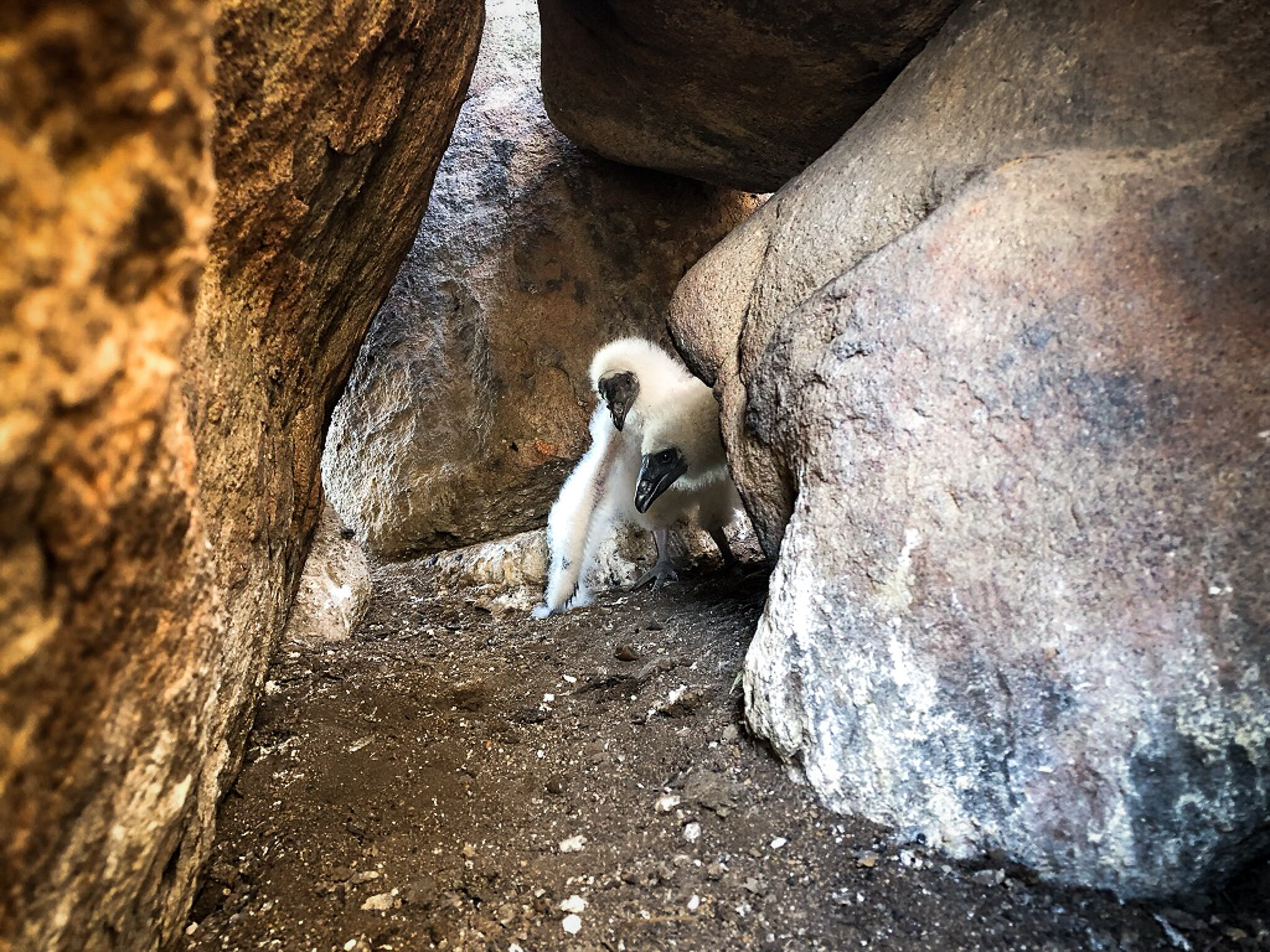
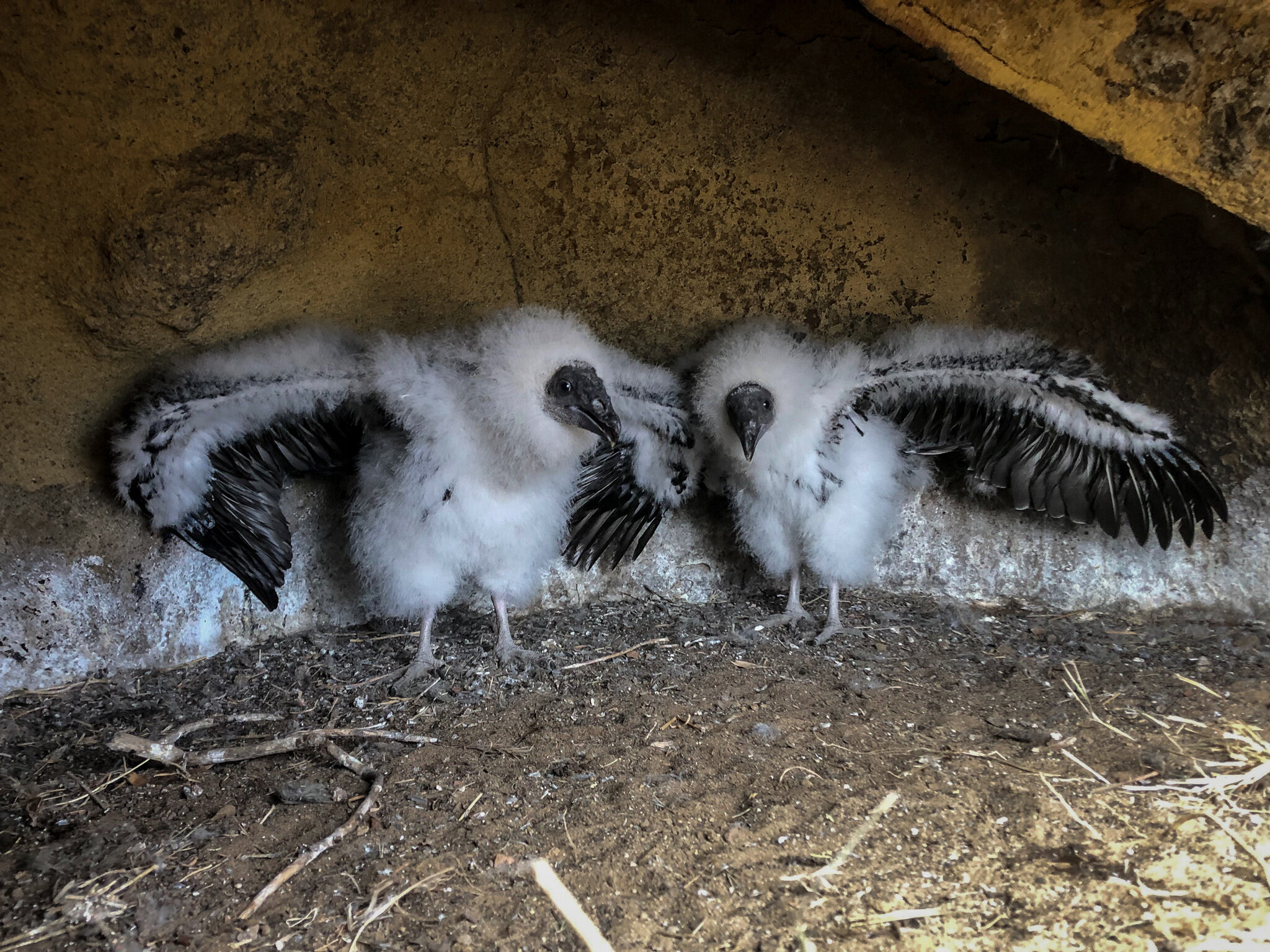
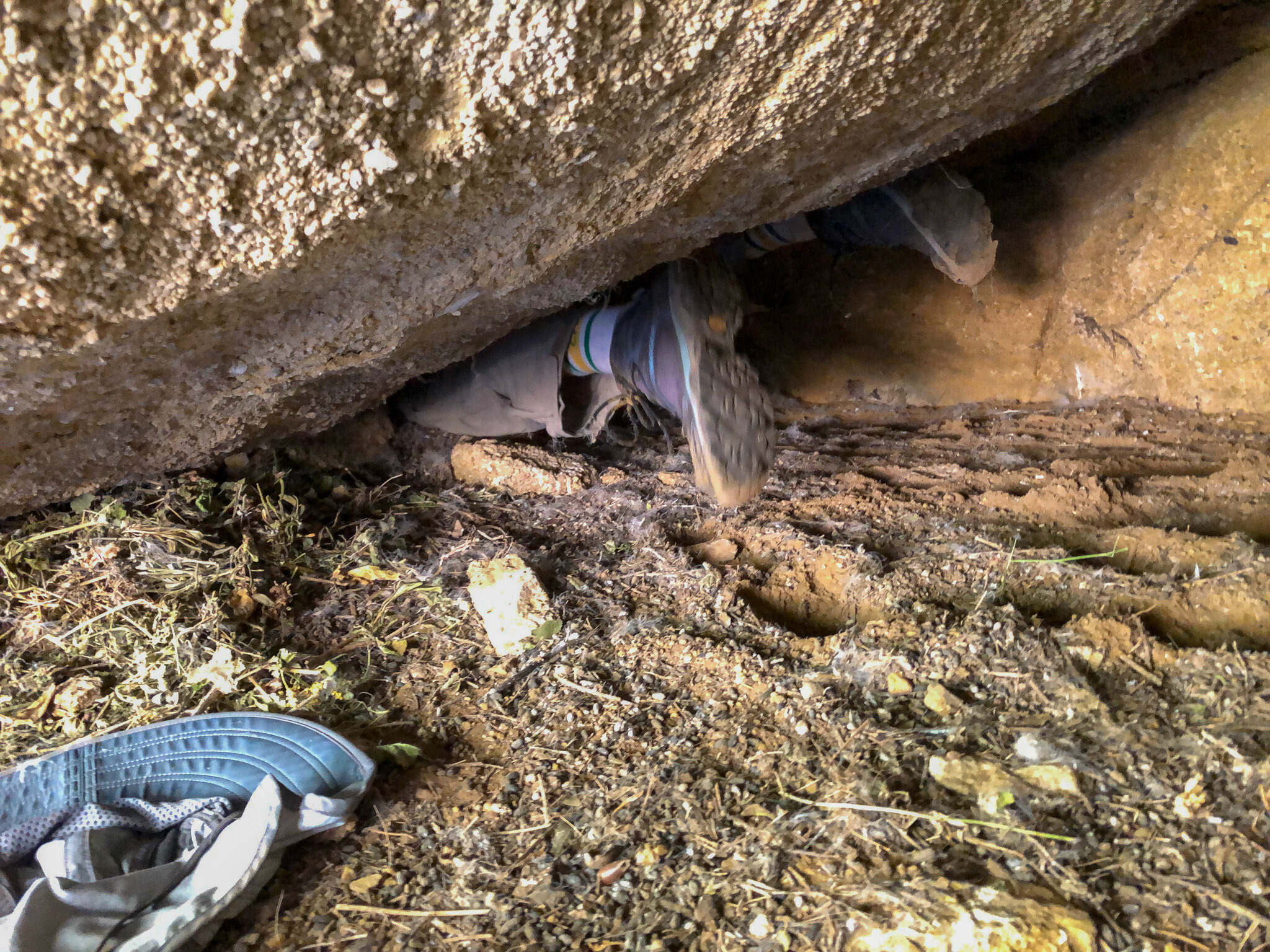
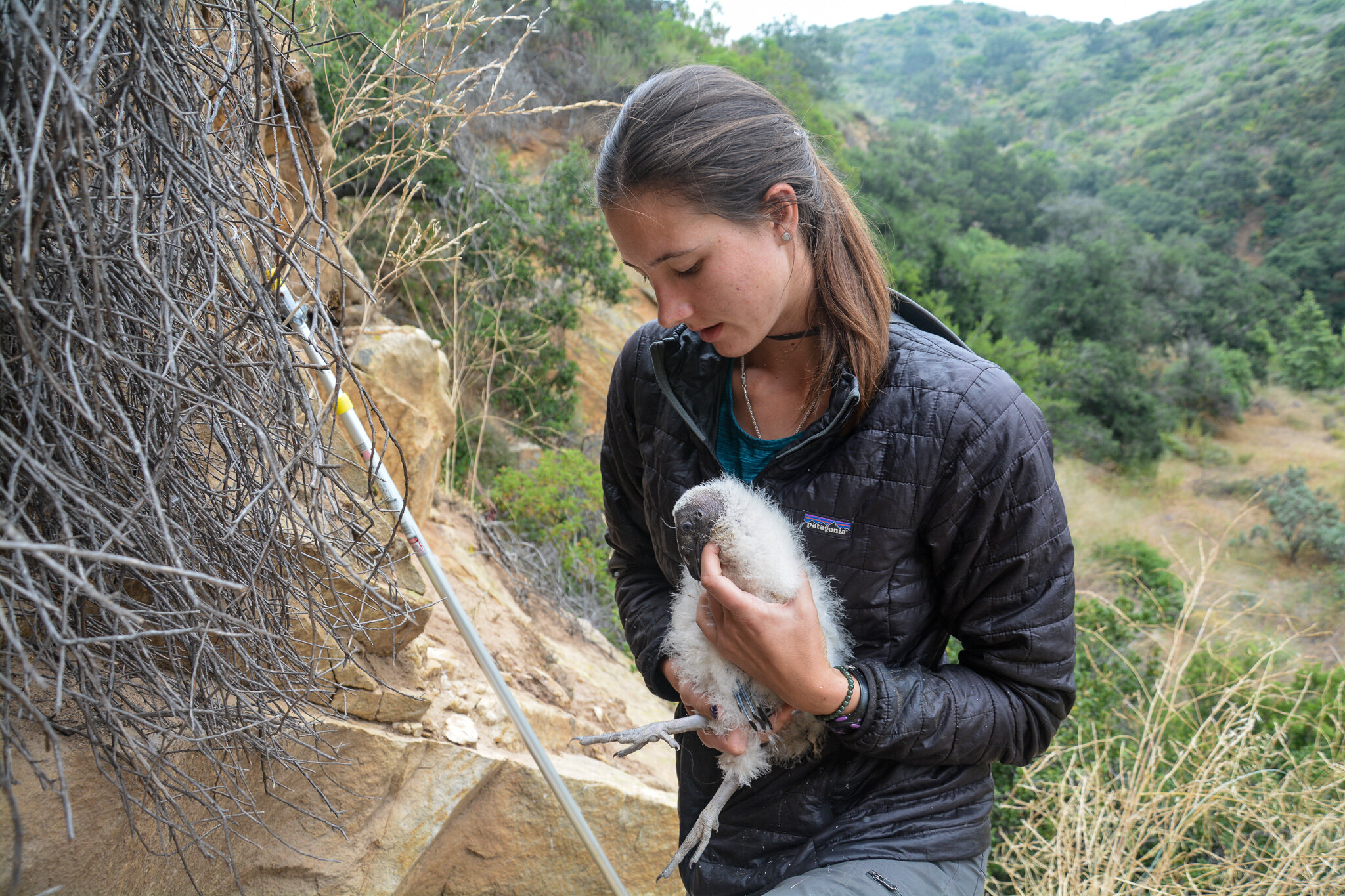
Photos above show several different Turkey Vulture nests with chicks. Turkey Vulture research is hard work, and sometimes involves crawling into tight spaces! Last photo shows Alex G. holding a chick prior to performing venipuncture. Photos Copyright: Peter Bloom.
What should you do if you see a bird with a wing tag? Just like with banded birds, any sightings within the United States should be reported to the USGS Bird Banding Lab, which can be done online at www.reportband.gov. They maintain a centralized database of all the banded and tagged birds, so submitting your sighting to them will ensure the correct researcher receives an official record of your encounter. After reporting the band and/or tag, you will receive a certificate of appreciation, which will include further details of when and where the bird was tagged, age of the bird, etc. We rely on the public to provide the majority of our banded and tagged bird re-sights. Since vultures (and condors) don’t have leg bands, the way to report them is a little different than other regularly banded birds.
To report a wing tag, you will need the following information:
The wing tag code (including any symbols); please note, code may be all numbers or alpha-numeric
Tag Color
Which wing - Right and/or Left
Date and location of bird sighting (when entering the location, if you do not have exact coordinates, it is helpful if you describe the exact location in the Comments section)
Any other information, such as interesting behavior
Go to: www.reportband.gov, click Continue (instructions will continue in English, or you may select one of the other available languages)
Select I am the finder
Report as Color Marker Only, click Continue
For species, type in Turkey Vulture
Select the other encounter information from the drop-downs – How Obtained will most likely be “Saw or photographed…other marker while bird was free” (but there are other options available if needed). If you noticed a symbol on the tag, such as a dot below the numbers, you will need to include that detail in the Comments section, as only alpha-numeric characters can be entered in the code box.
Click Continue after finishing each section to move to the next tab. Enter as much information as you are able. If any required info is missing, the website will flag the missing data. You are also able to send a photo after you submit your report.
If the tag is white with a black code, feel free to click here to send a note and/or photos to us – these photos help show us how the tags appear over time, as well as document the condition of the vulture. Occasionally Pete may use our database photos in educational presentations or handouts, with permission, so if you send us a photo, please let us know if it is ok to use your photo for these types of purposes (all names are on photos for copyright unless anonymous is preferred). We understand if you would prefer that your photos not be used publicly - your photos will still be stored in the database, but will be kept separate for internal reference only.
“N8”. Photo Copyright: Dr. Miguel D. Saggese (2021), used with permission.
Hopefully you have learned something new, and maybe even gained an appreciation for the amazing bird that is the Turkey Vulture. With bird-watching and long-lens camera photography gaining popularity as outdoor activities, we expect to continue to receive more and more reports of tagged vultures. Maybe now, you will find yourself looking a little closer at any large black bird you see soaring over your head.
UPDATE: This article has garnered a lot of attention online, and we are very grateful to everyone who has reported their sightings, or shared information about this research on their social media platforms! Please keep sending us your sightings and photos! To clarify - all research is done under Pete Bloom’s non-profit organization Bloom Research, Inc. - studying raptors is time consuming and there are many expenses; often these projects have been funded by Dr. Bloom himself when no other funding sources are available. If you would like to check out his other research projects, or if you would like to make a monetary donation, please visit www.bloomresearch.org - Bloom Biological, Inc. is a separate entity and cannot receive donations. Thanks again for your interest in the majestic Turkey Vulture - Happy Birding!
Written By: Nicollet Overby
